Occasionally notable ingots are unmarked, but still worthy of mention due to their clear pedigree, history, origin, or obvious time of manufacture. Where feasible, we summarize the unmarked and undesignated ingots here. If ingots are unmarked, but well identified then they will instead be presented within their respective pages by Assayer, Maker, or similar.
2.10 oz. 19th Century Unmarked Silver Ingot.
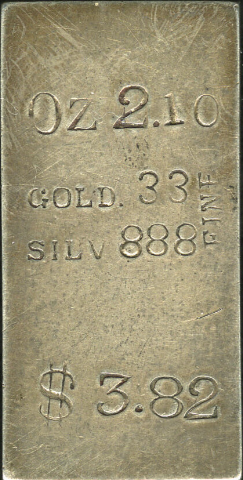
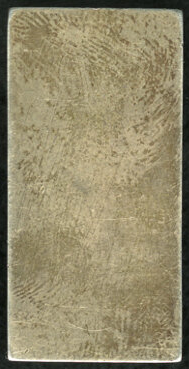
This unmarked silver ingot has a precious metals content that is consistent with many Western silver mines of the nineteenth century. It may have been an exhibition ingot, made to sit adjacent to some high grade ore specimen from a specific mine and placed in a display case for one of the many mining exhibitions. There is no information on the ingot to prove its source, and the only way to ascertain what mining district it came from would be through advanced metal “fingerprinting” techniques. The ingot face simply reads: Oz 2.10 / GOLD .33 / SILV 888 / FINE (rotated 90 degrees) / $3.82. Light gray patina overall with no significant surface impairments.
From The Alan Bingel Collection.
G $5.16, S $2.86 Gold and Silver Ingot. 19th Century Unmarked.
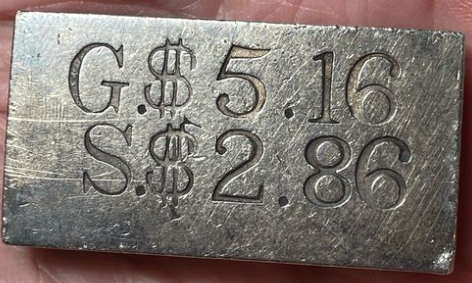
Not much is known about this ingot, but it resurfaced in late 2023 and was quickly snatched up and placed into a private collection. This mixed metal ingot has about a 1/4 oz worth of gold in it – pretty unique!
3.4 oz 1880’s Silver Ingot 777 Fine, $3.26 Monetized, Anonymous
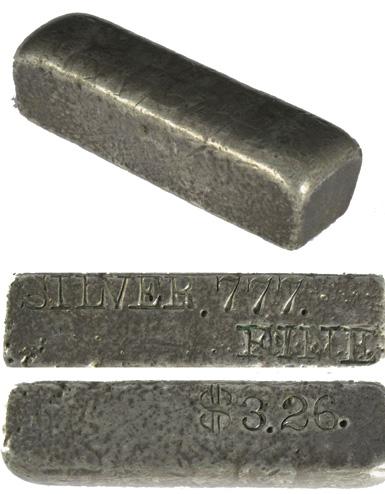
This is a classic legitimate historical ingot. Cute 3.4 troy ounce silver ingot, probably used as an exhibition piece placed next to an ore specimen from one of the west’s mines. This ingot shows 777 fine silver, $3.26. The low value may indicate here the period of time when silver began falling in price which precipitated the silver wars in Congress. There is no assayer’s mark here, possibly because of the purpose of the ingot.
[10/2010] https://www.icollector.com/NV-no-date-Crude-1880-s-Silver-Ingot_i9799658 ($1,200)
4.16 oz Gold Hill, Nevada. 1867 silver bar, $5.50.
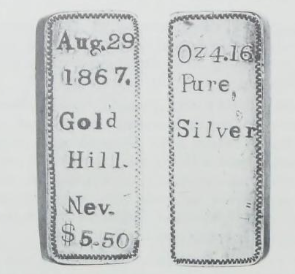
Originally attributed to Thomas Price in the Clifford sale, but may just as well be tied to Conrad Wiegand. Rectangular bar or ingot with ornamented borders on front and back. The front bears the inscription, hand-punched, in several lines as illustrated: AUG. 29 / 1867 / GOLD / HILL. / NEV. / $5.50. The reverse has the following inscription: OZ 4.16/ PURE / SILVER. The edges are plain. Extremely Fine or better. Attractive toning.
The Virginia City Union, October 14, 1863, published an account of the mines at Gold Hill and their early owners:
Late in the fall of 1858 [it was really in January 1859] four men, named James Finney, alias Virginia, John Bishop, alias Big French John, Aleck Henderson, and Jack Yount were prospecting in the vicinity of a place where Gold Hill is now situated … as they were passing along the ridge immediately east of the canyon in which the town of Gold Hill is now located, Virginia pointed to the large mound, now known as Gold Hill, and remarked to his comrades ‘Boys, 1 believe there are some good diggings over there. In a few days we will go over and try it.’
They returned . . . and in a few days went to the mountain pointed out by Virginia, as agreed upon . . . Virginia, in hunting around over the mound, discovered a hole which had been made by a gopher. From this they took out a considerable quantity of gold and carried it down to Crown Point ravine … all there immediately thought they had at last found the long looked for El Dorado . . . and the bleak mountains which surrounded them echoed and re-echoed their wild shouts of delight. They immediately staked out four claims of fifty feet each and divided them among each other, giving Virginia, as a discoverer, the first choice. A few days afterward five other men, named James Rogers, Joseph Plato, Sandy Bowers, Henry Comstock, and William Knight who had been prospecting in and about Spanish Ravine, came down to the newly discovered diggings and staked out another claim of fifty feet, being ten feet to each . . .
Ore from the district yielded both gold and silver, with gold attracting the greatest interest in the early days.
Bowers & Ruddy, Clifford Collection, Lot 228, 1982 March.
Sold by Empire Coin Co. (Q. David Bowers mid James F. Ruddy) to New Netherlands Coin Co., December 1965. Later by the latter firm to Henry Clifford on January 27, 1966.
[03/1982] https://archive.org/details/henryhcliffordco1982bowe/page/n103/
The font and crenelated border matches a 2.10 oz Silver Conrad Wiegand ingot with reverse inscription: “E. B. Monroe to Sarah A. Monroe;”.
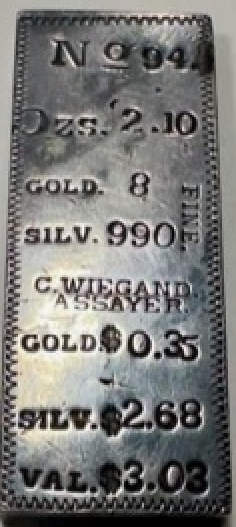
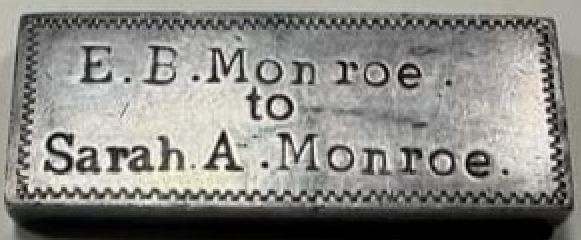
Another silver ingot “J. L. Pascoe 1868; reverse: From a Friend.” pictured below once again matches the same font and style of border engraving.
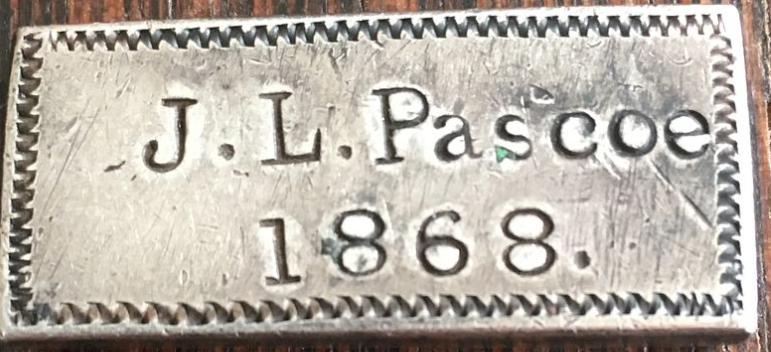
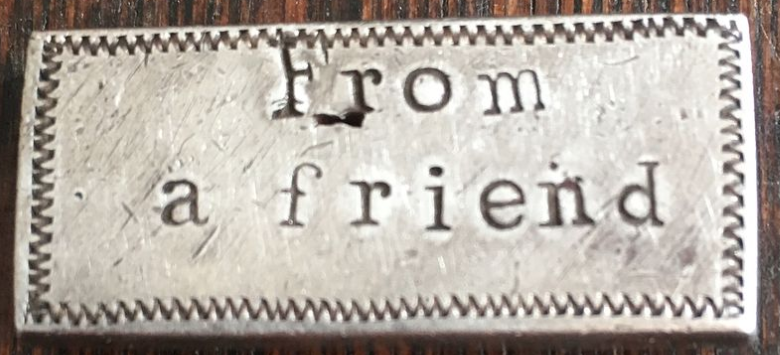
8.0 oz Unnamed Western Assayer’s Ingot. Mixed Metal, Gold and Silver. (7.96 ounces actual weight). Face Value: $13.33. circa 1880
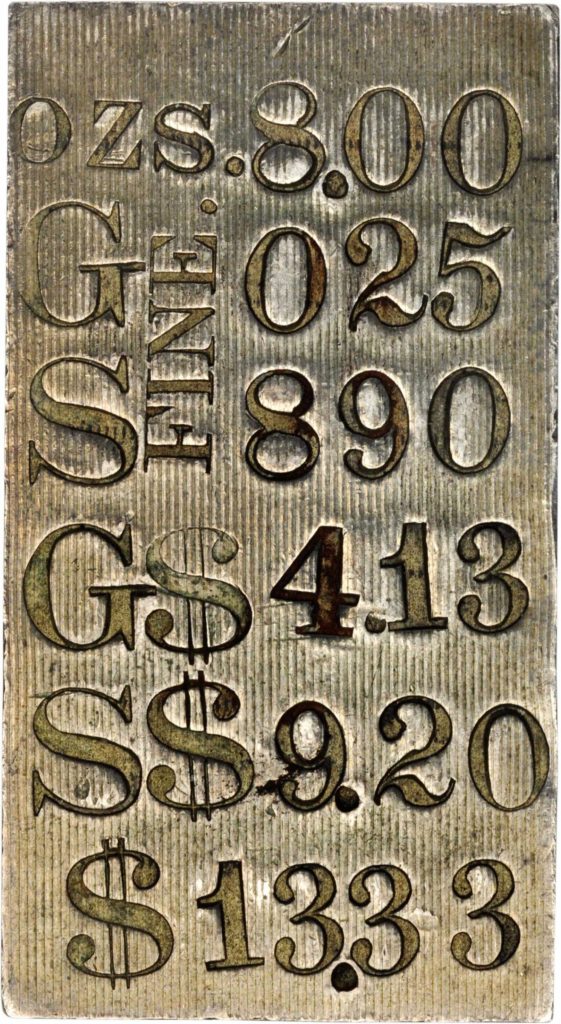
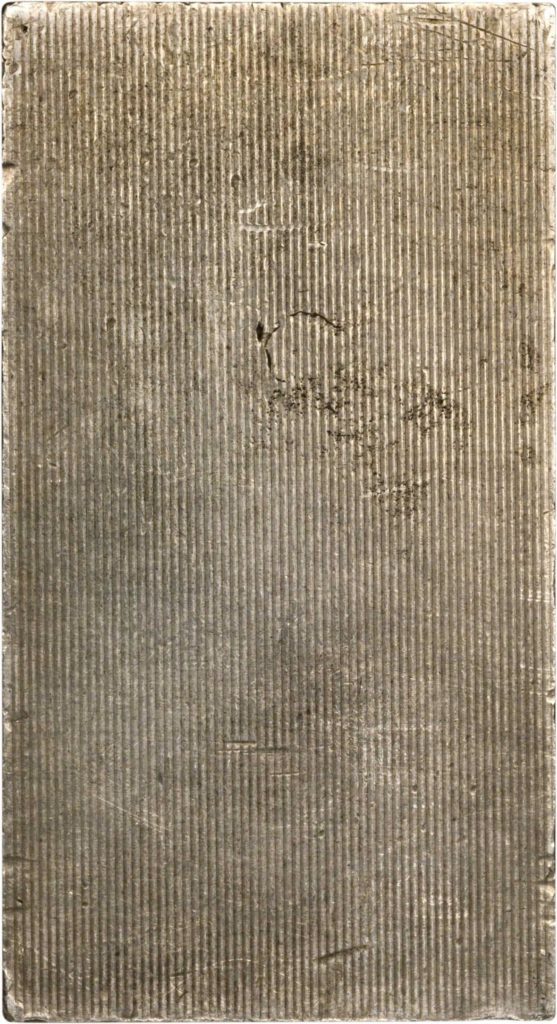
27.9 mm x 51.4 mm x 16.9 mm, extremely fine. An outstanding bar of particularly fine finish. Lustrous light silver gray with a faint olive-gold overtone and light debris caked in a couple of the face digits. The face gives the fineness as 025 gold, 890 silver, with the face value of each being $4.13 and $9.20, respectively. The face markings are neatly and deeply impressed, each being from an individual punch save for the word FINE, which is likely a logotype punch. Prior to the assayer’s application of the punches, the bar was very finely prepared as if intended for presentation, though there is no such engraving. The cooling depression was ground away, and the entire surface of the ingot was finished with fine parallel lines. The edges and corners are sharp save for a couple of spots where they have been gently bumped in handling. Application of the punches has slightly distorted the edges of the face where the punches were close to the border. Overall, evidence of handling is minimal, the mark of an ingot well cared for from an early time.
It is most unfortunate that this handsome ingot does not bear its maker’s mark. While most bars bear such identities, it is not without precedent to find one that does not.
While we have not been able to arrive at such a match for this piece, the bar fortunately does not come to us completely without context. It has descended through a California family with ancestors who are believed to have arrived in the area of Virginia City, Nevada in 1877. The consignors of this bar inherited two ingots, this one and a larger one that was a presentation bar beautifully inscribed to an identified member of their family tree. They have elected to retain the presentation bar due to its clear family connection, but we enjoyed the opportunity to carefully study it in person. The presentation bar is less fine than this one, but bears the mark of E.A. Martin & Co. Assayers, Virginia, Nevada. This is the only bar from this assayer of which we are aware. Dr. Martin was associated with the Comstock Lode Assay Office of Virginia City, and operated out of offices at “C” and Taylor Street in Virginia City. We are aware of one assay receipt bearing his name, dated May 1, 1880.
While family legend has it that two brothers arrived in Virginia City in 1877, the first official record of their presence in the area that we are aware of is an 1875 Nevada state census. Though it does not provide their towns of residence, it identifies one in Ormsby County (which then contained Carson City), and the other in Nye County. An 1878 business license for the Monarch Saloon in Carson City, located across from the Virginia and Truckee Railroad depot, is the first record of their specific location. The historical record reports one of the brothers as the proprietor of the saloon, the other as a barkeeper. The 1880 Nevada census shows one brother still in Carson City, the other having relocated to Eureka, Nevada. By 1882, one brother had left the area, and it is assumed, though not confirmed, that the same is true of the other. Thus, we have dated the present bar to circa 1880 since the brothers were in the area for just a short time.
All such assay ingots are rare, and those without makers’ marks present a particular challenge as to proper context. This lovely piece comes with promising evidence regarding its origin.
6.90 oz Unmarked, Silver Exhibition Ingot
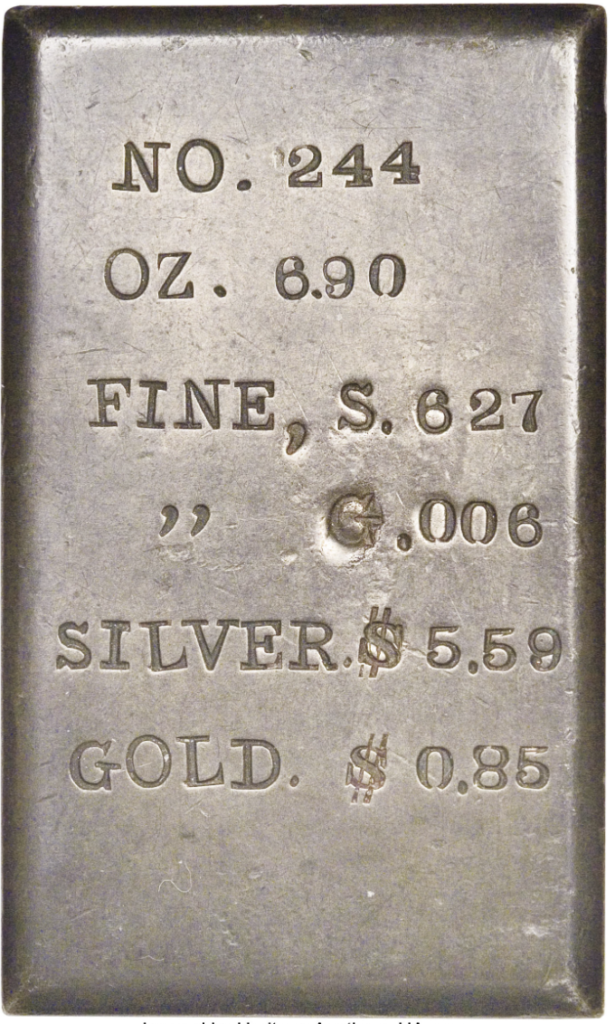
The top side bears all the imprints on this exhibition ingot. It reads: NO. 244 / OZ. 6.90 / FINE, S. 627 / ” G. 006 / SILVER $5.59 / GOLD $0.85. This exhibition ingot is of quality construction, probably dating from the 1870-1875 period. It has no Federal tax stamps, thus most probably post-1867. It has no assayer’s name, and was probably used in an exhibit next to the ore specimens from which the silver in this ingot came.
In researching the early 1860s western silver discoveries, low silver and gold content, as occur in this ingot, is very anomalous. The other anomaly is the “missing” metal in this ingot, which is probably copper, one of the few metals that occurs naturally with silver and gold as a by-product in potentially high concentrations. Only Markleeville, Alpine County, California has the distinction of having such a high copper content in conjunction with a silver/gold content and ratio as occurs in this ingot. The Leviathan mine, a silver-copper mine near Silver Mountain and the central camp of the mining district, was managed by Conrad Wiegand (the Virginia City assayer) and Mr. Rickard. In the 1871 Statistics of Mines and Mining in the States and Territories West of the Rocky Mountains, author Ross Raymond noted that the Leviathan ores ran up to 50% copper. Curiously, a different copper-rich silver-gold ingot from Wiegand is known in a private collection. Two other mines nearby with “argentiferous” copper ore were the Morning Star and Globe. All three mines were opened about 1863-4.
From The Kagin Reference Collection of Frontier Ingots.
Small Cast Silver Ingot. No. 199 (on back). Face Value: $2.50
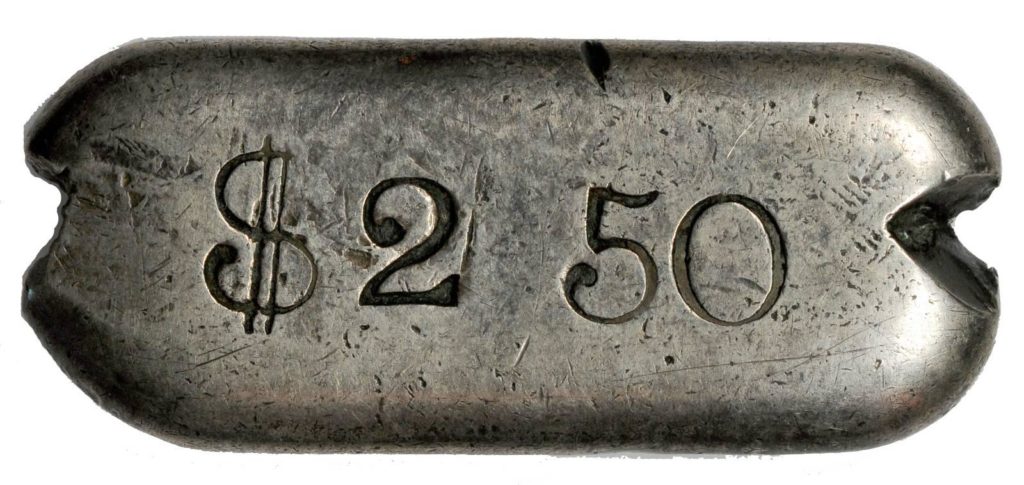
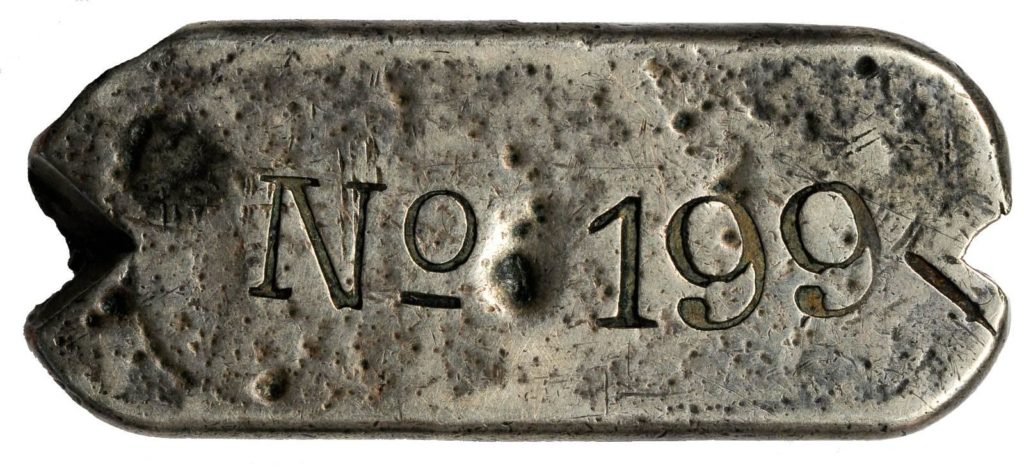
28.4 grams. 43.3 mm x 18.6 mm x 4.4 mm. Individual Letter Punches. VF. Small triangular assay chips from each end. No identifier of maker. Stylistically, this appears to be a turn of the century product, but a specific date of manufacture is not possible to ascertain. This does not seem to be a standard “ingot” in the classic gold rush sense, as if it is pure silver then the value of $2.50 does not correspond to the weight. The possibility exists that it could be mixed metal, but it is highly unlikely that a known gold content would not be identified on the bar. A charming and most curious little ingot.
Further examination is required, including an XFR to determine if any gold is present.
[08/2012] https://auctions.stacksbowers.com/lots/view/3-5W8WG/small-cast-silver-ingot-no-199-on-back-250-on-face-individual-letter-punches-vf (Passed)
1.90 oz $3.68 Face Value unmarked silver ingot
An unmarked ingot in the same case bears only the fineness and dollar value. It is probably an exhibition ingot, but lacks punches identifying its location. It has the appearance and fineness of a circa 1860-1880 Comstock ingot, but could be from another silver district.
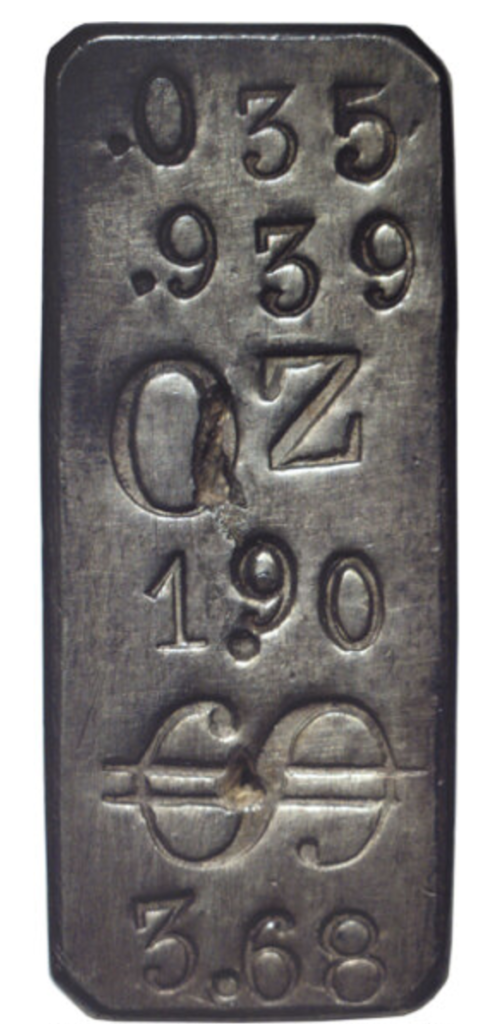
From The Kagin Reference Collection of Frontier Ingots.
[08/2006] https://coins.ha.com/itm/ingots/belcher-mine-comstock-lode-virginia-city-1876-this-ingot-is-from-the-belcher-mine-an-exhibition-ingot-used-at-the-phila/a/414-2568.s (2 ingot lot; price mixed)
Unidentified issuer, “E(?) C.P.” Gold & silver refined
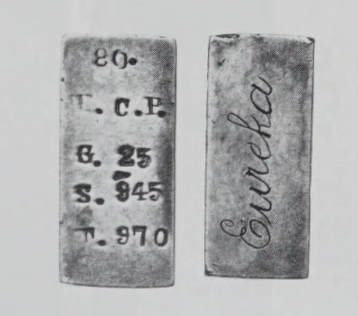
Presentation bar, 672.9 grains. Gold .025 Fine, Silver .945 Fine. Total .970. (Photo) ($500-Up)
Obverse has, in addition to Fineness data, “80” punched in at top. Reverse reads “Eureka” in engraved script: left edge engraved “M. E. Pierce”. Right edge engraved “M.E.W.” in script. Bottom edge reads “1899”, engraved. Top edge has what seems to bean engraved monogram, “IH”. An extremely unusual piece, in that no value is specified. Purchased at 2/77 Long Beach, Cal., Convention.
[04/1980] https://archive.org/details/allanleescottcol1980numi/page/144/
5.50 oz B. B. Silver Ingot
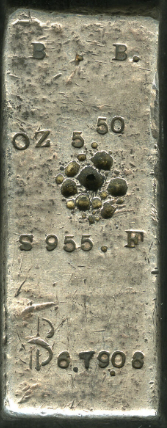
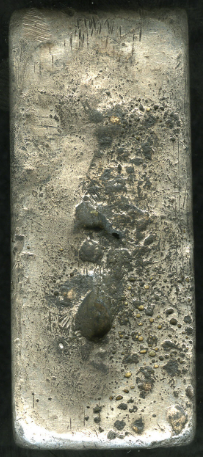
This small silver ingot marked with two B’s is of uncertain origin. It is a classic exhibition ingot, typical of those made to be placed in a public display of the nineteenth century, often or generally placed next to the ore specimens from the mine where the silver was extracted. The ingot’s precious metal content is indicative of a Western U.S. silver deposit, though without more definitive information, its historical background is speculative.
There is only one firm located in San Francisco with two men as partners with the letter B. This was the Bradshaw brothers, Samuel C. and George H. Bradshaw. Their business was called the Pacific Metallurgical Works located at 511 Sacramento Street, San Francisco. They were a classic Civil War-era assay and metallurgical testing firm.
Pacific Metallurgical got its start in 1860 with the advent of the great Comstock discoveries. It was a public company, with 500 shares of stock issued at $100 each. S. Hastings was the president, long associated with Comstock mine finance and later namesake of the Hastings School of Law, California’s oldest law school. Bradshaw was one of the directors. A metallurgical lab was built by G. Fouque utilizing European techniques of ore extraction. The mill treated five tons per day, and was located on North Beach, a site that also housed mills for several other companies. The Bradshaw brothers were noted as the proprietors after 1864, and the facility appears to have lasted under the Bradshaw management until about 1866.
The company continued for more than a decade, though under different ownership. If this ingot was made by the Bradshaw brothers, it dates to 1864-1866 while they were the proprietors. Its style is consistent with other small ingots made during that period.
This small silver ingot is simply laid out with very small letter and number punches with the only information on the top side. The face reads: B. B. / OZ 5.50 / S 955. F / $6.7908. The surfaces are light gray with a cluster of gas bubbles in the center of the face and the usual concavity in the middle of the back side.
From The Alan Bingel Collection.(#10340)
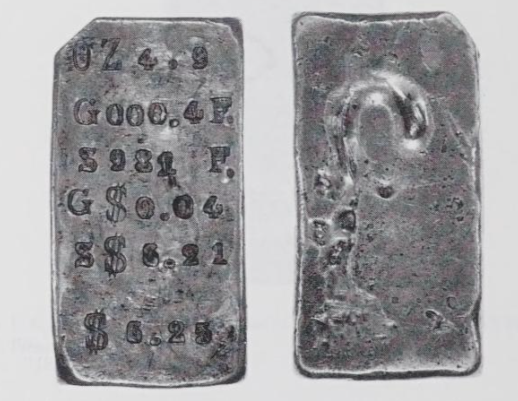
Anonymous mixed assay Silver Bar. From top to bottom the inscriptions reads: OZ4.9 / G 000.4 F. / S 981 F. / G $0.04 / S $6.21 / $6.25. Extremely Fine. Size is 1 X 2”. Weight in grammes: 151.10. Letters and numerals are punched in using individual figure punches.
[02/1992] https://archive.org/details/centurycollectio1992supe/page/346/
Two Small Silver Ingots, Stamped MSM and FWC
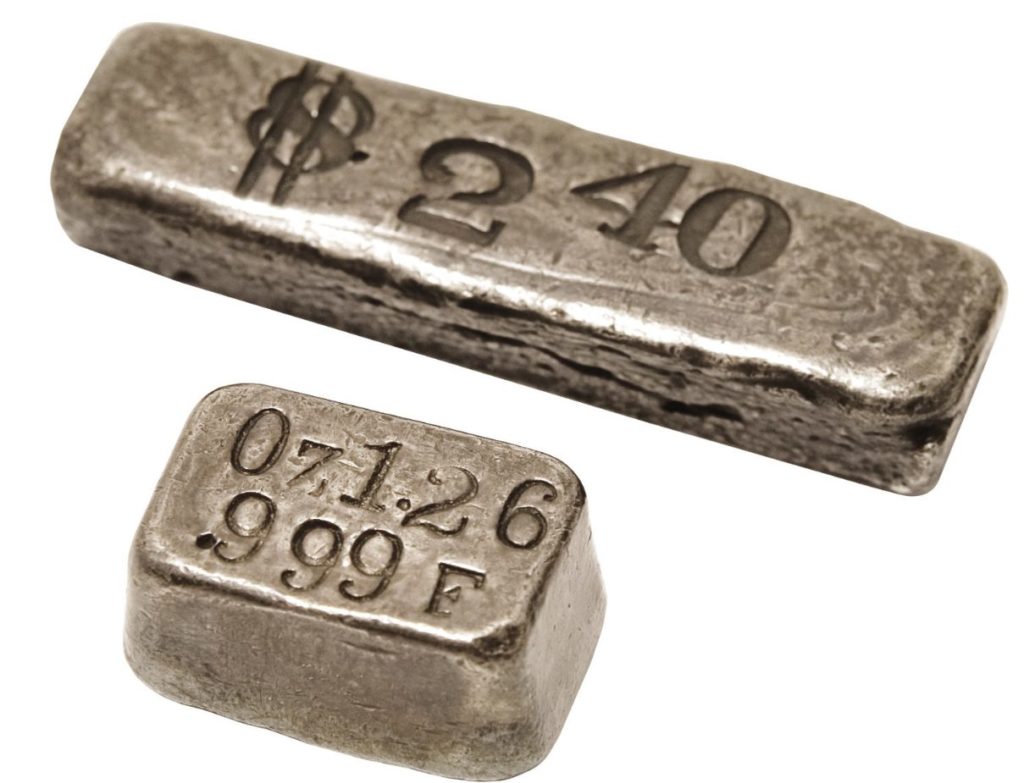
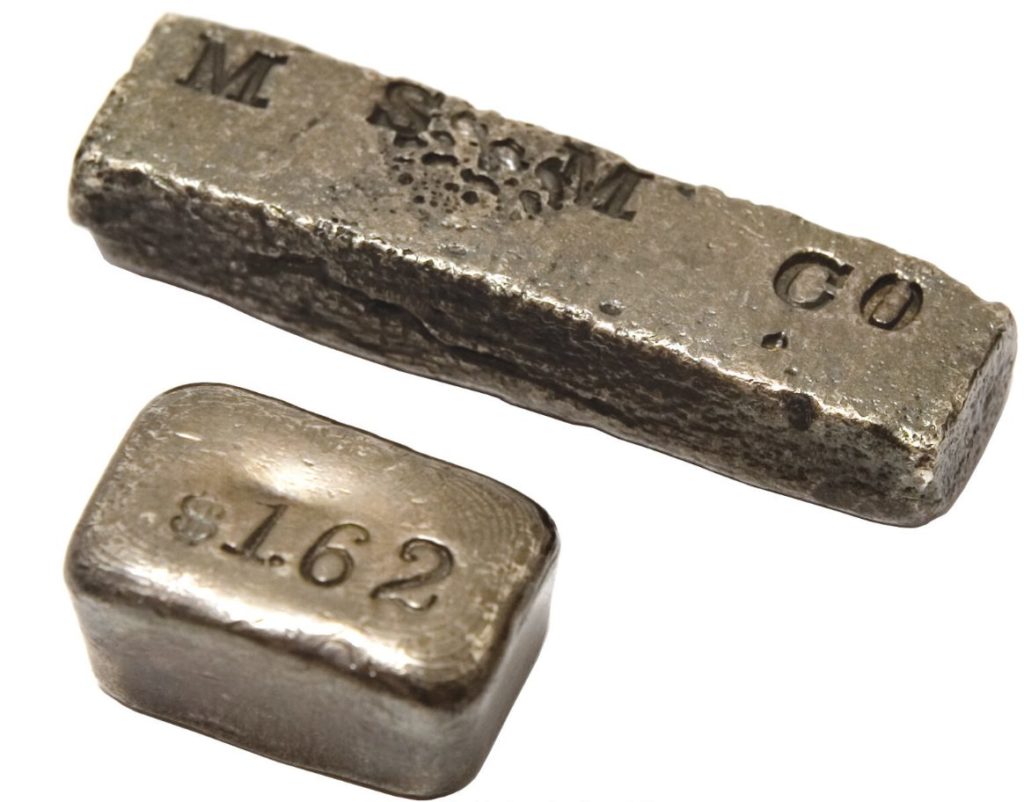
Two Silver Ingots. One is crudely stamped “M S M Co,” as if to indicate a Silver Mining Company whose name began with an “M,” and the other is stamped 999 fine, “F. W. C.”
- First Ingot Top: $2.40
- First Ingot Bottom: M S M CO
- Second Ingot Top: Oz 1.26 999 F
- Second Ingot Bottom: $1.62
Both ingots bear attributes that question their age. At the same time, one must keep an open mind, because many early ingots are quite crude, and often what appears obvious, or obviously wrong, has a reasonable explanation.
The FWC ingot carries three initials unique to western assayers. Only F. W. Clark, an assayer in Golden, Colorado in 1880 carries those specific initials. No other western assayer, out of nearly 6,000 entries in a private data base, carries those initials. It should be noted, however, that the initials could also be for a mine owner or superintendent, though most are of the assayer that made the ingot. The 999 fine is a problem. Most western assayers did not refine silver, but it is not out of the question. Numerous professional papers of the period instruct assayers in the science of refining. It was not necessary, however, because the U.S. branch mints and U.S. assay offices generally did not pay a premium for refined metal to make it worthwhile. It was sometimes, though rarely, done for expositions.
The MSMCo silver ingot could be any mining company with the first initial of M. It also has problems, lacking the fineness and weight, while carrying the dollar amount.
From The Kagin Reference Collection of Frontier Ingots.
[08/2006] https://coins.ha.com/itm/ingots/two-silver-ingots-one-is-crudely-stamped-m-s-m-co-as-if-to-indicate-a-silver-mining-company-whose-name-began-with-an-m-/a/414-2578.s ($1,035)
J NO. G. – Two Unidentified Silver Ingots
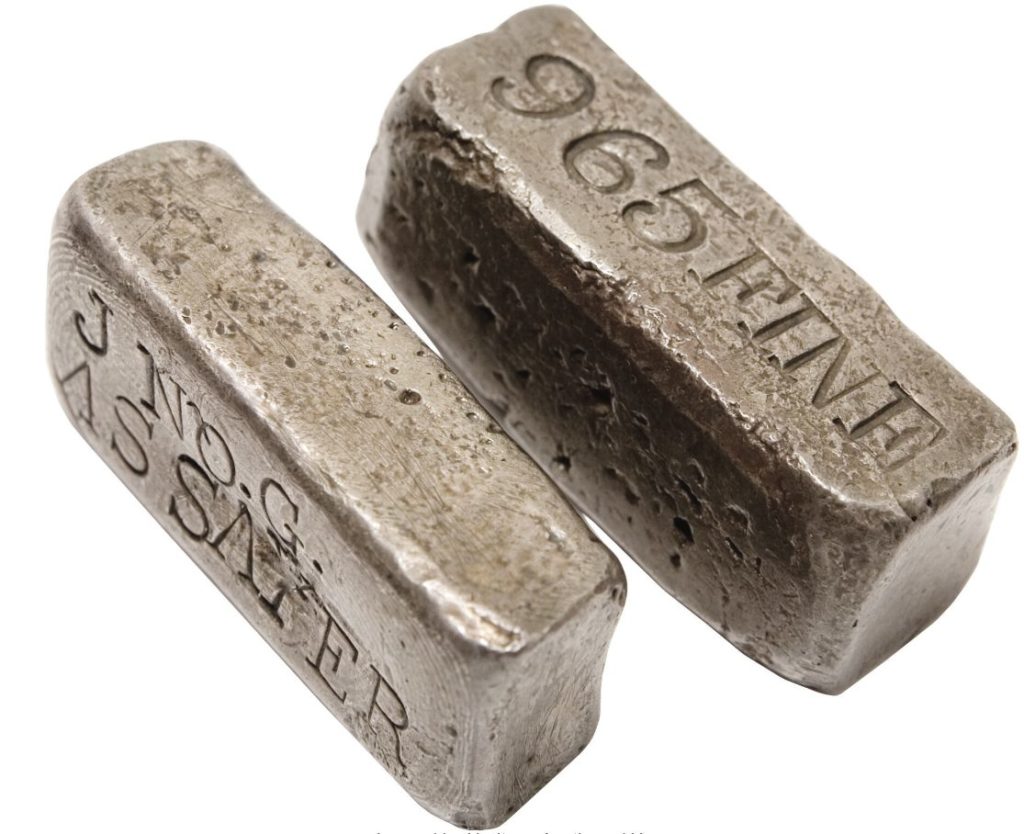
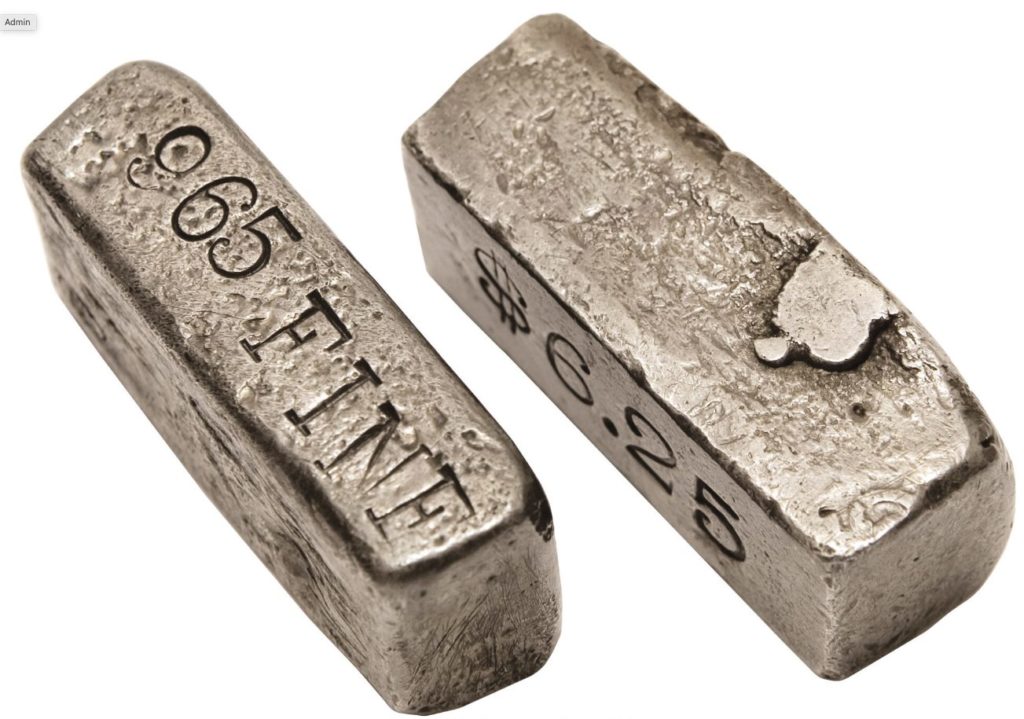
Two Silver Ingots. One piece is very crude, a 965 fine bar with no assayer info. The other is crudely stamped Jno. G. Assayer, an abbreviation for “John G.”
- First Ingot Top: $6.25
- First Ingot Bottom: 965 FINE
- Second Ingot Top: J NO. G.
- Second Ingot Bottom: 965 FINE
These two crude ingots have several problems, such as lacking the assayer identification, and the other with an assayer’s name punched on the apparent wrong side of the ingot. There are no assay chips, and no fineness noted. These ingots could have no specific purpose, such as an exhibition, presentation, or mine ingot, because they are improperly marked. But this does not preclude them as private keepsakes.
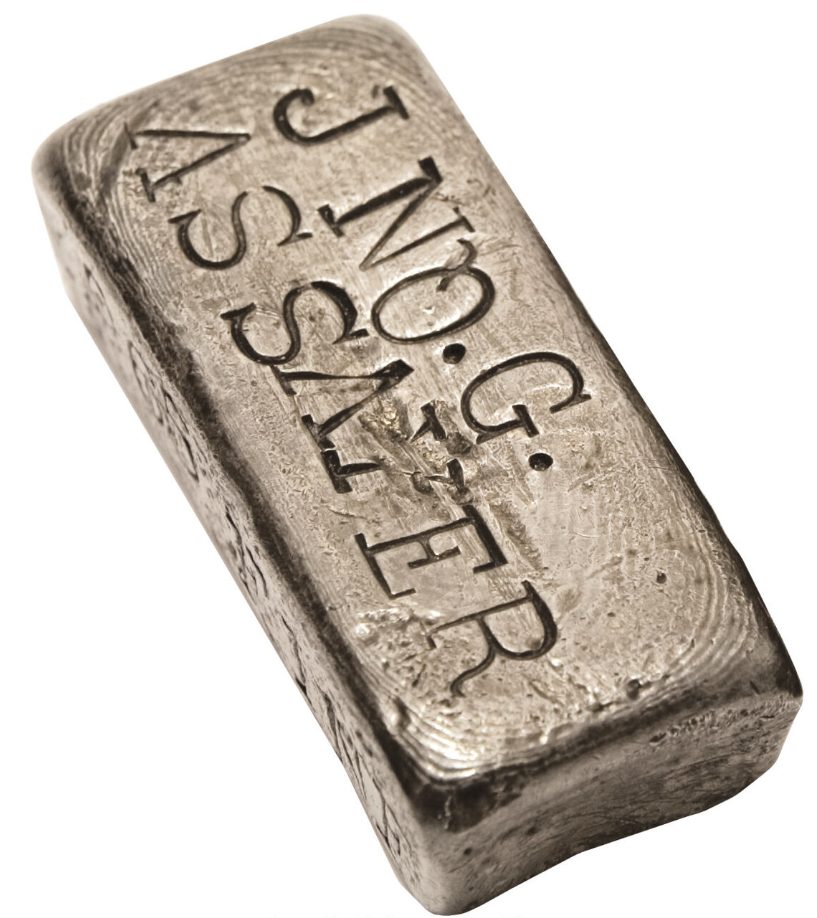
There are only two John G. assayers on a privately prepared western assayer list from 1852-1900. These are John Goldsworthy, Los Angeles, 1880-1887, who would have perhaps assayed Darwin or Cerro Gordo ores; and John Griswold, San Francisco, 1880-1883, who would have perhaps assayed Nevada or Napa silver ores.
From The Kagin Reference Collection of Frontier Ingots.
[08/2006] https://coins.ha.com/itm/ingots/two-silver-ingots-one-piece-is-very-crude-a-965-fine-bar-with-no-assayer-info-the-other-is-crudely-stamped-jno-g-assaye/a/414-2574.s ($2,990)
2.41 oz Utah Silver Ingot and Two Silver Weights
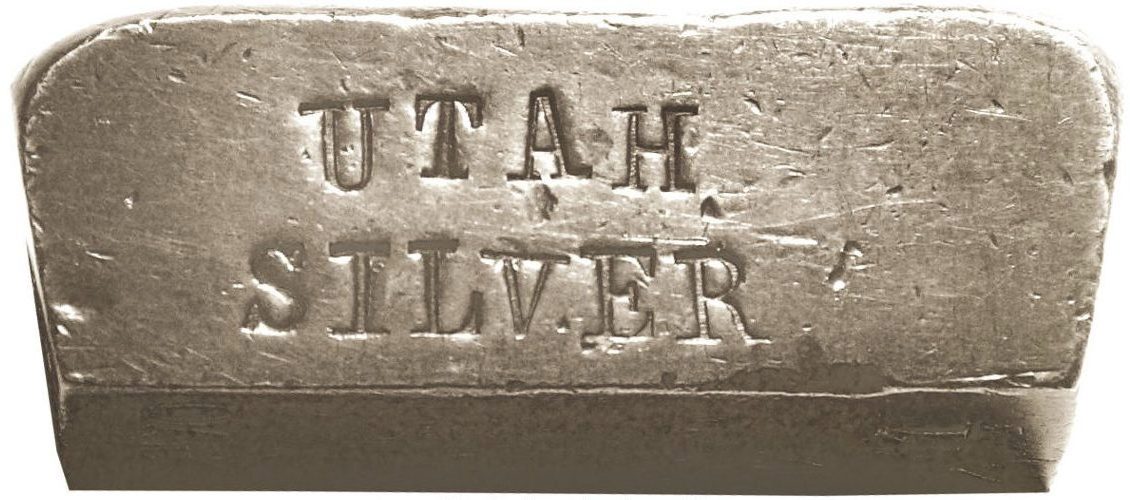
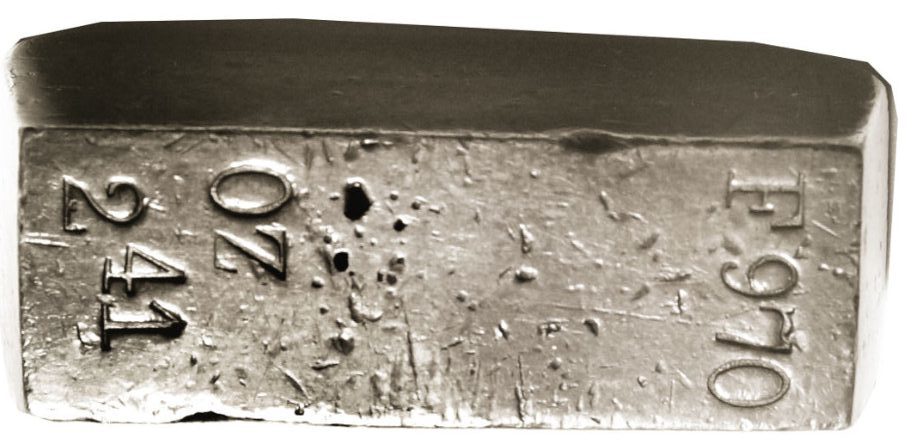
Utah Silver Ingots. Three pieces are in this lot. The ingot is trapezoidal with imprints on two sides. One long side states UTAH SILVER. The top side reads: F970 / OZ / 2 41. No period is used in the weight, but the numbers that express a part of an ounce are raised above the 2. Medium gray patina.
This ingot is made in the typical fashion of 19th century western U.S. ingots made for exhibition, perhaps residing in a display case next to a high grade silver ore specimen from a specific ore deposit. The term “Utah Silver” is potentially confusing, because it could refer to silver mined in Nevada while it was Utah Territory (1859-1861), or it could be from a Utah silver mine from a later date. Coincidentally, this ingot nearly matches a larger “loaf” style ingot made for R. C. Chambers (now in a private collection), superintendent of the famous Ontario mine in Utah, owned by George Hearst and his partners, that produced great quantities of silver in the 1870s. Detailed metal analyses would confirm or deny a direct association.
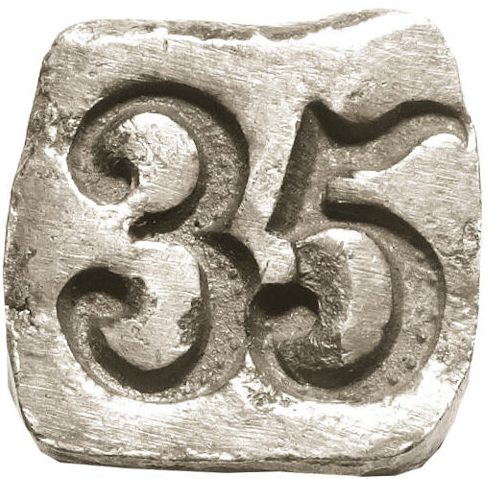
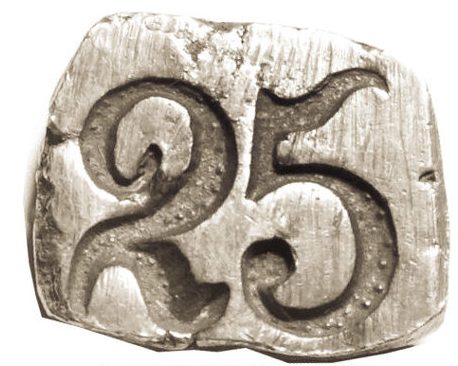
The silver weights that accompany this ingot are marked “25” and “35.” They have no apparent relation to the Utah ingot, and appear to have been placed in the case for convenience. These two pieces are quite different from normal ingots, and were once thought to have represented coin in denominational amounts. However, these two pieces of silver, which exhibit careful chipping and filing (which generally represent an adjustment in weight), are indeed exactly as they represent–weights of 0.25 and 0.35 troy ounces. The markings and use are purely as weights for precious metals (hence fractions of troy ounces, not avoirdupois ounces), easily usable for pocket scales and weighing placer gold. These unusual and rare pieces are likely 19th century, though the maker and age is nearly impossible to ascertain.
From The Kagin Reference Collection of Frontier Ingots.
[08/2006] https://coins.ha.com/itm/ingots/utah-silver-ingots-three-pieces-are-in-this-lot-the-ingot-is-trapezoidal-with-imprints-on-two-sides-one-long-side-states-utah/a/414-2585.s ($6,325)
Silver-Gold Ingot c1900, Face Value: $8.33
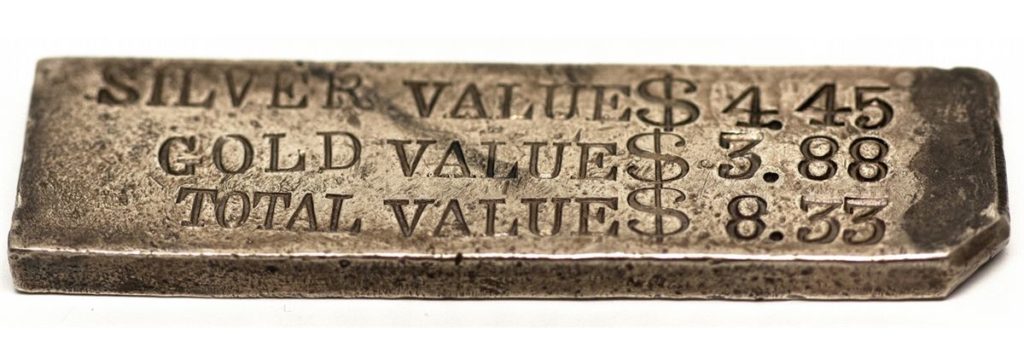
Weighs 5.25 troy oz and measures 3.50” x 1.” Engraved on one side of the ingot is “Silver Fine 655, Gold Fine 35.8.” The other side reads “Silver Value $4.45, Gold Value $3.88, Total Value $8.33. This original silver-gold ingot shows two assay chips from the same corner. Its rectangle shape leads to the conclusion that it was used in mining exhibitions. It would have been placed next to ore specimens from mines.
[08/2012] https://www.icollector.com/Silver-Gold-Ingot-c1900-2012aug-Numismatic_i13391202 ($3,585)
6.31 oz Silver Ingot–Unknown Maker.
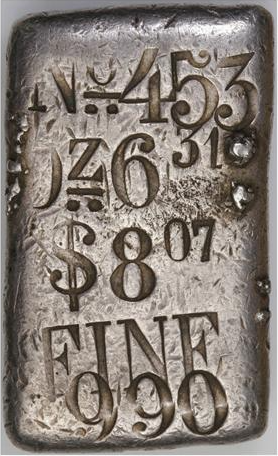
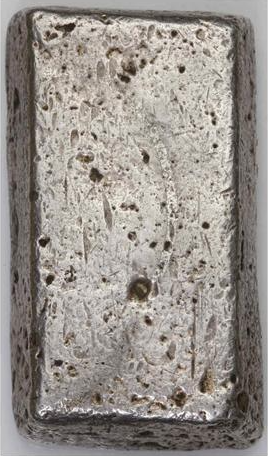
No maker is indicated on this small-sized ingot, but it has the appearance of a late 19th century or early 20th century item. The serif lettering and fancy 5 are suggestive of a piece from this period. Only the top side has any information and it reads: No 453 / Oz 631 / $807 / FINE / 990. Several raised bumps are seen on the top side, and there are also several handling marks. Numerous small casting imperfections are noted on the back side.
[01/2006] https://www.icollector.com/Silver-Ingot-Unknown-Maker-6-31-ounces-No-maker-is-i-Silver-Ingot-Unknown-Maker_i5384176 ($2,640)
6.85 oz Nondescript Poured Silver Ingot
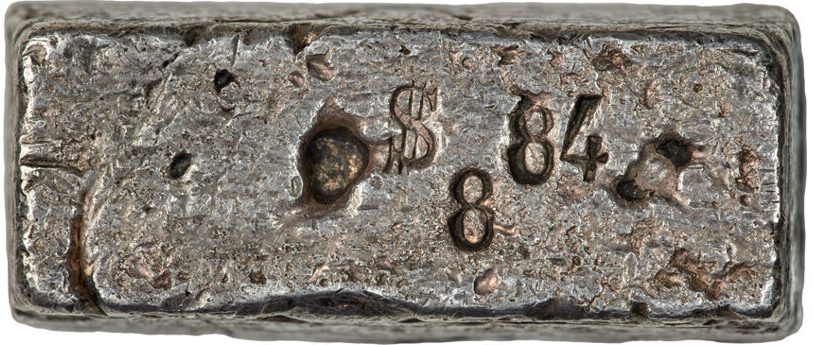
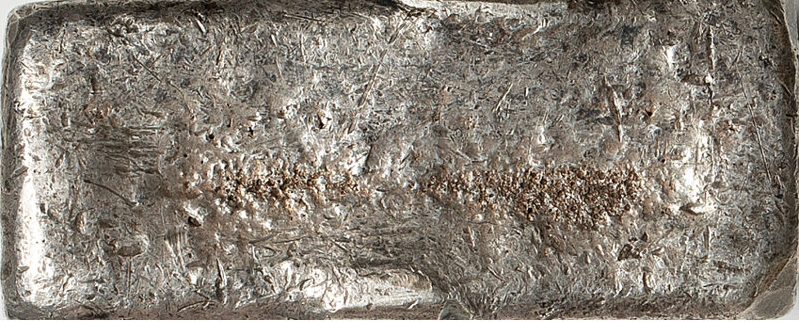
19mm x 23mm x 54mm. $ 8 84 is stamped on the face, with no other inscriptions ($8.84). A crudely made ingot with several fissures in the sides from a three-pour cast. Likely 19th century production.
[09/2024] https://coins.ha.com/itm/ingots/nondescript-poured-silver-ingot-685-troy-ounces-19mm-x-23mm-x-54mm-8-84-is-stamped-on-the-face-with-no-other-inscript/a/63300-92002.s ($3,360)
Small Gold Mill Bar, C. 1860-1885


Gold ingot engraved ‘Mill Bar’ on one polished face. This ingot is 1.3” x .3″ wide x 1″ thick. .426 troy oz. Trapezoidal shaped gold ingot made in a classic c. 1860-1885 style. Polished on all sides, it may represent a first mill product, a common form of commemoration for any mill when the first ores are processed. The resultant gold ingot or ingots were usually kept or presented to the mine manager, superintendent, or owner as keepsakes. This particular bar may have been made for use as a watch chain fob, which was typical of many of the small silver ingots known from the early 1860’s.
Deep orange-gold color over all the faces. Close examination reveals a few light scratches and handling marks, but there is no evidence it was mounted as a fob.
[01/2010] https://coins.ha.com/itm/ingots/c-1860-1885-small-gold-mill-bar/a/1136-3403.s ($1,955)
3 3/4 oz Enigmatic Small Gold Bar. CAL NATURAL GOLD

38.1×20.0×12.5mm.
Top: CAL.
Bottom: NATURAL GOLD 3 3/4 OZ FINE .947.
All edges blank.
No assayer or mine or mill name. A fairly rough cast, one short edge with cooling flaws. We do not have any further information about the origin or date of this piece.
[01/2002] https://archive.org/details/americanacolonia2002stac/page/58/
Anonymous Assayer “1849” Ten Dollar Gold Ingot AU55 Uncertified.
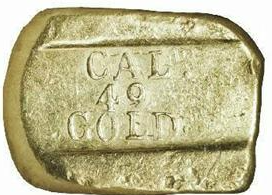
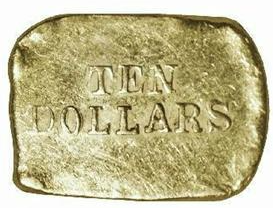
22.9 x 16.8 x 3.6 mm.
Inscribed CAL. / 49 / GOLD on the face in three lines and TEN / DOLLARS on the back in two lines.
This unique ingot is listed and illustrated by Don Kagin on page 312 of his 1981 reference “Private Gold Coins and Patterns of the United States.”
His description states:
Specie Ingot.
- Obv. CAL/49/GOLD
- Rev. TEN/DOLLARS
Kagin further noted: “Little is known concerning this ingot. It may have antedated both Moffat & Co. and Norris, Gregg & Norris. One can also speculate that only a well-known firm, perhaps Moffat & Co., could issue an ‘unnamed’ ingot and expect it to circulate without question.”
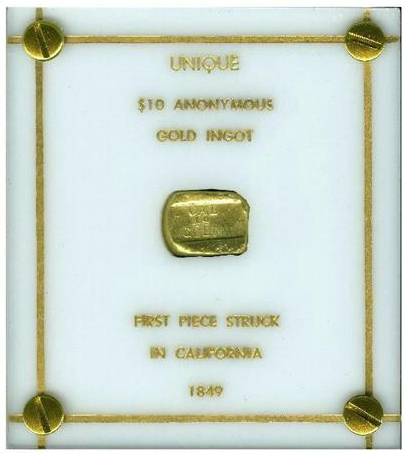
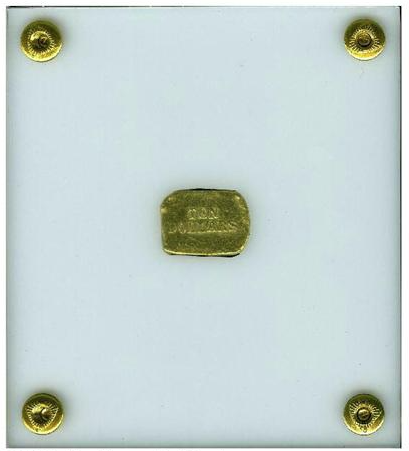
Perhaps it can be punch linked to one of the known issuers of gold ingots, which would identify the maker and help to unravel its mystery. The bright greenish-gold color of this ingot is typical of native California gold with its high silver content. The actual lettering on each side has the appearance of being punched from logotypes, rather than individual letter punches. On the front, GOLD is clearly doubled and possibly tripled. The individual letters on each side are formed differently, for example, the A and L on the front, and those letters on the back, clearly have different shapes which would most likely eliminate the use of individual punches. Listed in the Guide Book in the late 1950s, and also in the 1995 edition of Coin World’s Comprehensive Catalog and Encyclopedia of United States Coins.
From The Great Western Collection of Territorial Gold.
[08/2005] https://www.icollector.com/Anonymous-Assayer-1849-Ten-Dollar-Gold-Ingot-AU_i5251924# ($18,600)
